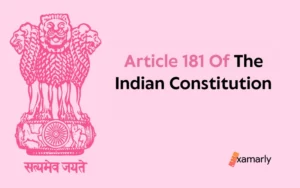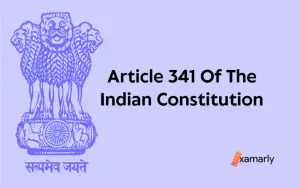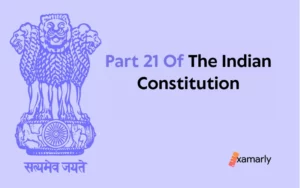One can argue that a state should not be allowed to use its powers to dissolve its own Legislature, but Article 365 of Indian Constitution does give the President such power.
It can be used to disband the Legislature and make a fresh reference to the electorate. However, this may be interpreted as an undemocratic practice. Further, the Constitution does not mention the constitutional provisions on a government with no opposition.
In this article, we’ll delve into a deep understanding of Article 365 of the Indian Constitution.
- Article 365 of Indian Constitution
- History of Article 365 of Indian Constitution
- Provisions of Article 365 of Indian Constitution
- Key Points about Article 365 of Indian Constitution
- Imposition of President's Rule under Article 365 of Indian Constitution
- Consequences of President's Rule under Article 365 of Indian Constitution
- Cases of Invoking Article 365 of Indian Constitution
- Misuse of Article 365 of Indian Constitution
- Similarities among Article 365 & Article 356 of Indian Constitution
- Summary
- FAQs on Article 365 of Indian Constitution
- For how long can a President's Rule last in a state?
- What is the purpose of Article 365 of the Indian Constitution?
- What function does Article 365 of the Indian Constitution serve?
- What connection does the Indian Constitution's Articles 365 and 356 have to one another?
- Which is high in priority in terms of the President's Rule, Article 365 or 356?
Article 365 of Indian Constitution
Article 365 of the Indian Constitution deals with the failure of a State to comply with, or to give effect to, any direction from the Union Government. It empowers the President of India to issue a proclamation, declaring that the State has failed to carry out its constitutional obligations.
This proclamation can lead to the imposition of President’s rule in the State, where the Governor of the State acts as the President’s representative and assumes the powers of the State government.
It allows the Union executive power to give directions to the State Governments. In cases/times when any State fails to comply with, or work on, any directions given by the Union, the President would have the power to legally hold that the concerned State Government cannot be carried on in accordance with the provisions of this Constitution.
In short, this empowers the President to assume powers from the state government. It is a key aspect in learning about the centre-state relations.
This extraordinary power is referred to as President’s rule. While it provides a wide range of possibilities, it is rarely used. It also provides for the power to dissolve the State legislative assembly.
Article 365 of the Indian Constitution is closely related to Article 356 of the Indian Constitution as both deal about the powers of the president in case a State fails to comply with the Union’s directions or the constitutional machinery of a State fails, respectively. In a way, both lay out the foundations of President’s Rule.
However, both of them are brought into effect in cases of breakdown of law.
Under Article 356 of the Indian Constitution, the President has the power to impose martial law or declare a state of National Emergency to conserve the provisions of the Constitution of India.
Also read about Financial Emergency on: Article 360 of the Indian Constitution.
History of Article 365 of Indian Constitution
It was included in the Indian Constitution during the drafting process in 1949. The framers of the Constitution believed that it was necessary to have provisions in place to ensure that the States would comply with the directives and orders of the Union Government.
This has been used several times in India’s history, most notably during the Emergency period between 1975 and 1977. The then-Prime Minister, Indira Gandhi, invoked it to impose President’s rule in several States that were ruled by opposition parties.
Since then, the use of Article 365 & 356 has been controversial, with some experts arguing that it gives the Union Government too much power over the States. In recent years, however, its use has become relatively rare, and the Supreme Court of India has issued several judgments restricting the scope of the article.
- The first instance was in 1956, when President Jawaharlal Nehru dismissed the Punjab Chief Minister, Gopichand Bhargava, despite Bhargava enjoying a majority in the state legislative assembly. The Centre, fearful of a communist State Government, sought to dissolve the government, which was approved by the parliamentary body.
- The instability of the Centre during the 1970s led to the dismissal of state governments not controlled by the ruling party.
- In addition, the Janata Party and Congress used Article 356 to overthrow elected governments.
- To combat this, the then President V.V. Giri established the Governors’ Committee, which was led by Bhagwan Sahay and looked into governor-related matters. It also included Gopal Reddy, Aliyaver Jung, and S.S. Dhawan. The committee issued its recommendations in 1971.
- The governors were now responsible for maintaining political stability and alerting the President if any internal disturbances or external aggression were suspected.
The Constitution has safeguards for misuse of constitutional provisions, but it doesn’t guarantee that political parties will follow democratic principles and ideology. This means that Article 365 of the Indian Constitution is only as good as the safeguards it contains.
Read Also: How to Study History for UPSC.
Provisions of Article 365 of Indian Constitution
Article 365 of the Indian Constitution empowers the President to take certain actions in case a State fails to comply with, or to give effect to, any direction from the Union Government. The key provisions of the article are:
- The President can issue a proclamation declaring that the State has failed to comply with the Union Government’s directives or orders.
- Once the proclamation is issued, the President can declare that the powers of the State government shall be exercised by the Governor of the State or by any other person appointed by him.
- The President’s rule in the State can continue for a maximum period of six months, after which it can be extended by Parliament for another six months, if necessary.
- The President’s proclamation can be revoked by him at any time, and the Governor can resume the exercise of his powers.
Any steps taken by the President shall have to also go through the Houses of Parliament and the Council of Ministers to the President, including the Prime Minister of India.
Overall, Article 365 gives the Union Government significant powers to intervene in the affairs of a State in case of non-compliance with its directives, but its use is subject to judicial review by the Supreme Court of India.
You might also like to read:
Key Points about Article 365 of Indian Constitution
Some key features about this article are:-
- It gives the centre the power to rule over states.
- It plays a vital role in centre-state cooperation.
- It imposes the President’s rule on states which fail to comply with the directions of the union government. This provision also applies to states that enjoy some degree of autonomy, as the Union government gives directions to every state.
- The powers granted by Article 365 are not absolute and must be exercised with due care and caution.
- Article 365 of the Indian Constitution is discretionary by its nature.
However, the powers granted under this article can be abused in some situations and should only be used when necessary.
Both the articles 365 & 356 are based on Section 93 of the Government of India Act, 1935. If Article 365 is misused, it could turn provinces into farce and may even lead to the formation of an unpopular government in the country.
You might also like to read: Administrative Relations Between Centre and State.
Imposition of President’s Rule under Article 365 of Indian Constitution
Following are the key points relating to the President’s Rule under Article 365 of the Indian Constitution:-
- President’s Rule refers to the situation where the President of India invokes Article 365 and declares that a State has failed to comply with the directives or orders of the Union Government.
- As a result, the President can declare that the powers of the State government shall be exercised by the Governor of the State or by any other person appointed by him, effectively imposing President’s Rule in the State.
- During President’s Rule, the Governor assumes the powers and functions of the State government, and the State Assembly is either dissolved or suspended. The Union Government can then take over the administration of the State through the Governor.
- However, it is important to note that the imposition of President’s Rule is a drastic measure and is only taken in extreme circumstances, such as in cases of breakdown of constitutional machinery or political instability, as mentioned in Article 356 of the Indian Constitution.
- The decision to impose President’s Rule is subject to judicial review by the Supreme Court of India, which has laid down several guidelines and restrictions on its use.
- Article 365 of the Indian Constitution is a powerful and rarely used power. In extreme situations, the President can impose his rule on a state without a referendum, as long as the state is complying with the central government’s directives.
- A President’s rule is a temporary measure to restore stability in a state, which can last for six months or longer. However, it can also be extended, in stages, for up to three years.
- A President may also impose the President’s rule in a state if there is no viable alternative to a democratically elected state government or no simple majority.
- Despite the provisions of Article 356 of the Indian Constitution, it should be used only when necessary and only as a last resort. If used correctly, the President should give a warning to the state and should not use it as a tool for settling political scores.
Also Read: Powers and Functions of Lok Sabha and Rajya Sabha.
Consequences of President’s Rule under Article 365 of Indian Constitution
In the event that a State Government stands against the directives of the Union Government, the President can impose the President’s rule. The consequences of a President’s rule are explained below:-
- The suspension of a state’s government may result in a halt in policy-making and decisions, or in the implementation of new laws.
- The Governor of the State assumes the powers and functions of the State government, effectively replacing the elected government.
- The State Assembly can be dissolved or suspended, and the Union Government can take over the administration of the State through the Governor.
- The civil and criminal courts of the State continue to function, but they are subject to the control and supervision of the Union Government.
- The financial resources of the State are also subject to the control and supervision of the Union Government, and the Governor can make appropriations from the Consolidated Fund of the State.
- The imposition of President’s Rule can lead to political instability and a breakdown of the constitutional machinery in the State, and it can have long-lasting effects on the State’s governance and development.
The last three times that Indian Presidents have invoked the Article were to overthrow a majority government. Indira Gandhi used it 27 times to dismiss state governments, usually when they were in a position of political instability or lack of a clear mandate.
The Union government has used this power to overthrow nine state governments led by the opposition. The most common uses were in Manipur and Kerala, both of which were affected by prolonged periods of violence and instability.
You might also like to read:
Cases of Invoking Article 365 of Indian Constitution
Since Independence, there have been 126 instances of President rule in various states. Some examples are as follows:
- The practice was first used in 1951 in Punjab, but it has since been used in every state once or twice.
- In 1959, President’s Rule was imposed in the State of Kerala after the Communist government refused to obey the directions of the Union Government.
- In 1963, President’s Rule was imposed in the State of Kerala again, this time after the government led by the Indian National Congress was dismissed due to allegations of corruption.
- In 1977, President’s Rule was imposed in the State of Tamil Nadu after the All India Anna Dravida Munnetra Kazhagam (AIADMK) government led by M.G. Ramachandran was dismissed due to allegations of corruption.
- During the Emergency between 1975 and 1977, President’s Rule was imposed in several States, including Bihar, Uttar Pradesh, and West Bengal, where the opposition parties were in power.
- In 1991, President’s Rule was imposed in the State of Meghalaya after the government led by the Indian National Congress was dismissed due to allegations of corruption.
Since then, the use of Article 365 has become relatively rare, and its use is subject to judicial review by the Supreme Court of India. The Court has issued several guidelines and restrictions on the use of Article 365, which has limited its scope and applicability.
If you want to know more about Indian States, our following blogs might help you:
Misuse of Article 365 of Indian Constitution
Article 365 of the Indian Constitution has been invoked in India on several occasions, and there have been allegations of its misuse by the Central Government.
It can be used as a political tool for various reasons like dismissing elected governments that were not aligned with the Central Government’s political agenda. This has led to accusations of the misuse of Article 365 and the undermining of the principles of federalism and democracy enshrined in the Indian Constitution.
For example, during the Emergency between 1975 and 1977, President’s Rule was imposed in several States where the opposition parties were in power. The imposition of President’s Rule was part of a larger crackdown on civil liberties and political dissent during the Emergency period, and it was widely seen as a means of consolidating the power of the Central Government.
Similarly, in 2016, President’s Rule was imposed in the State of Uttarakhand after the government led by the Indian National Congress was dismissed by the Central Government. The move was widely criticized by opposition parties and constitutional experts, who argued that it was an attempt to subvert the democratic process and to undermine the autonomy of the State government.
Overall, the misuse of Article 365 is a serious concern for the functioning of democracy in India, and it is important to ensure that the provision is used only in exceptional circumstances and in accordance with the principles of federalism and democracy enshrined in the Indian Constitution.
The President’s decision is also subject to judicial review as the Supreme Court ruled in the case of S.R. Bommai vs. Union of India. These measures surely reduce the misuse of Article 365 and ensure that it is only being used in exceptional situations and not at the will of a political party for political gains.
Similarities among Article 365 & Article 356 of Indian Constitution
In a debate, it became clear that Article 365 gave the President discretionary power over any decision. Article 356 and Article 365 of the Indian Constitution are two distinct provisions that deal with the constitutional relationship between the Union government and the State governments.
Article 356 pertains to the President’s power to impose “President’s rule” in a state in the event of a constitutional breakdown. In other words, it provides for the suspension of the state’s constitutional machinery and the imposition of direct federal rule in the state, if the President determines that the state government has failed to function according to the provisions of the Constitution.
On the other hand, Article 365 deals with the obligation of states to abide by the Constitution and to follow the federal laws made by the Union government. It provides that if a state violates or fails to follow the provisions of the Constitution or federal laws, the Union government may take action to ensure compliance.
Summary
Article 365 outlines the powers of the President in case where the State Government fails to comply with the Centre’s directions. Any federal government can survive only on Centre-State Cooperation and thus it is mandatory for both to act accordingly.
First, the State must abide by the laws and provisions of the Constitution and by the laws passed by the Parliament. Second, the state government must abide by the directives of the Central Government, which are mandatory. Article 365 is invoked only when the state does not comply with these directives.
FAQs on Article 365 of Indian Constitution
For how long can a President’s Rule last in a state?
The duration of a president’s rule is six months. In accordance with the Indian Constitution, it may also be prolonged for a further maximum of three years, in stages.
What is the purpose of Article 365 of the Indian Constitution?
The purpose of the article is to keep the working of State Governments in check by the Union. If seem from the good perspective & used wisely, it can help keep check on both the levels of the government.
What function does Article 365 of the Indian Constitution serve?
Article 365 plays an important role in maintaining the federal structure of the Indian Constitution and ensuring that the states follow the Constitution and federal laws. It helps to preserve the unity and integrity of the country by preventing states from challenging the authority of the Union government or violating the provisions of the Constitution.
What connection does the Indian Constitution’s Articles 365 and 356 have to one another?
Article 365 and Article 356 are two related provisions of the Indian Constitution that deal with the constitutional relationship between the Union government and the State governments. Article 365 requires the states to abide by the Constitution and federal laws, while Article 356 provides for the suspension of the state’s constitutional machinery and the imposition of direct federal rule in the state in the event of a constitutional crisis.
Which is high in priority in terms of the President’s Rule, Article 365 or 356?
Both are invoked when a state violates the Indian constitution. Article 365 comes first in the procedural aspect of the emergency, as the President can make a declaration under that provision.


![Article 365 of Indian Constitution [President's Rule] 1 Article 365 of Indian Constitution](https://blog.examarly.com/wp-content/uploads/2022/08/Article-365-of-the-Indian-Constitution-1160x725.webp)



